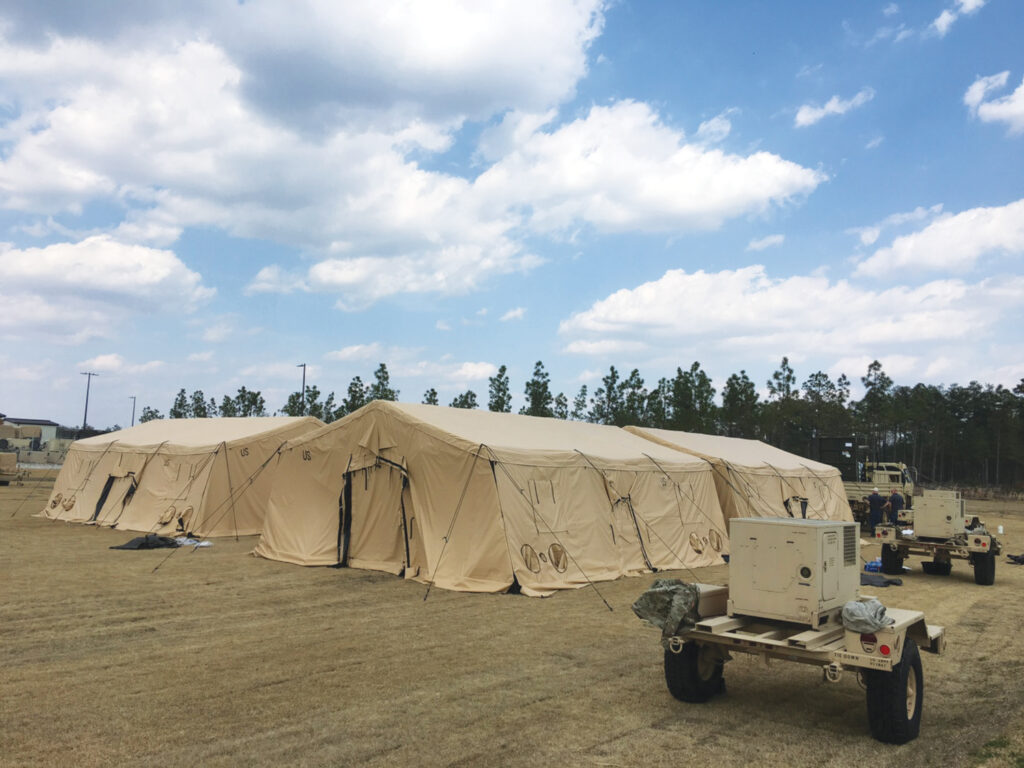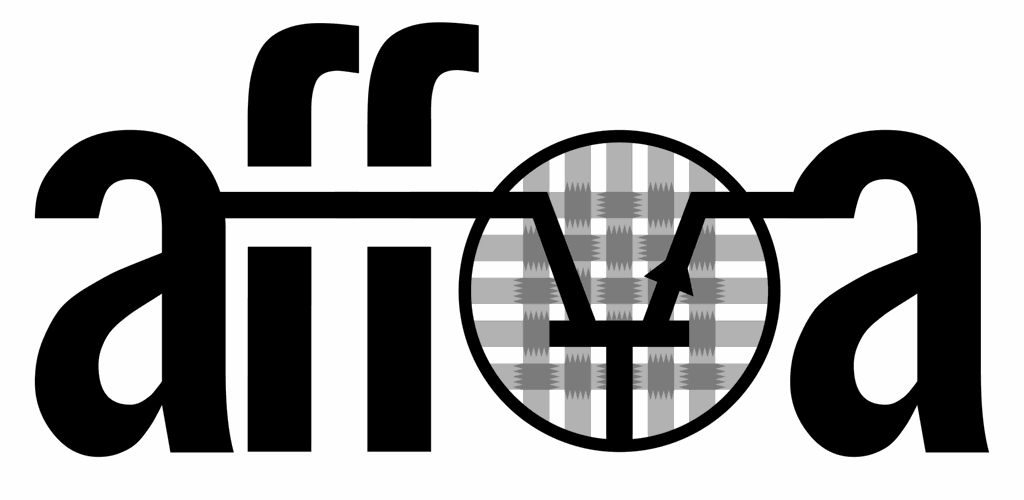Used for wedding celebrations, birthday parties, graduations, festivals and other events, fabric structures and tents serve a variety of lighthearted purposes. But these products also have a serious side, such as when they’re deployed for disasters, for humanitarian relief, for military operations or in first-responder situations. And although every event-focused setup has its challenges, issues can multiply when it comes to the more somber uses of fabric structures and tents, particularly since the demands can be severe in these situations.
One difficulty manufacturers as well as tent/event rental companies can face is that in most cases the need generally doesn’t give much, if any, advance notice, says Chad Struthers, vice president of Warner Shelter Systems Ltd. (WSSL). Headquartered in Calgary, Alta., Canada, WSSL manufactures party tents and fabric-clad structures for the event rental, oil and gas, aviation, military, and automotive markets, among others. Sales make up about 80% of its business, with rentals, primarily to large events/festivals, comprising the rest.
As Struthers explains, when it comes to the disaster arena, “There is no demand until there is a demand.” When this does arise, local rental houses are generally the first ones to get commissioned. If their inventory is out for other purposes—for example, it’s the busy wedding or event season—they have to start looking for alternative ways to meet the need, which is why Struthers advises establishing a relationship with a manufacturer that can rent to a company in emergency situations.

WSSL has provided structures in response to several fire events, such as the 2016 conflagration that hit Fort McMurray in Alberta, Canada, displacing more than 2,000 residents and three communities. At that time the company rented out tents of all sizes, says Struthers, sending these to one rental house, to two of the oil sands threatened by the blaze, and to the municipality of Wood Buffalo. In the summer of 2023, fires struck in the Yukon and in the Kelowna region of British Columbia, again forcing thousands to evacuate. But here, the impact on WSSL was comparatively minimal, with people simply purchasing smaller tents.
Struthers says for WSSL, requests from the emergency response community have included those for larger pole tents and clearspans, running in size from 40 feet by 80 feet to 40 feet by 100 feet, installed most often for command posts, mess halls, storage and warehousing. Smaller frame and marquee tents (10 feet by 20 feet or 20 feet square) are generally used for first aid, for the distribution of supplies and as information centers.
“When it comes to demand, it’s typically what will do the job, what will meet the need and what is readily available,” he says, explaining that urgency makes people more flexible about sizing.

Meeting the need
What is required of structures used for such purposes is quick deployment and the ability to tolerate demanding conditions, says Keith Krzeminski, executive vice president of Shelter Structures America. Located in Los Angeles, Calif., the company distributes a variety of clearspans to the U.S. and beyond, serving markets/industries such as disaster relief, emergency first response, event rental, military, hospitality and more. Among the structures he mentions as being especially useful for disasters/first response are the company’s A-frame clearspans.
“These were created out of a need to provide a tenting option that is more robust than a traditional frame tent,” Krzeminski explains. “A-frame structures are able to stay up long term while withstanding the elements. They also offer more options such as hard wall or glass wall, lockable doors for security and more.”
A-frame options include the company’s disaster relief tents, useful when time and resources are scarce and there’s a high demand for help. In addition to being lightweight and easily transported, what makes these particularly well-suited is their fast installation time, ensuring that command centers, triage, medical facilities and so on can be up and running quickly, he says.
The tents are constructed with high-strength aluminum alloy, encompassing the classic A-frame design, and are available in several sizes. The tarpaulin consists of multilayer PVC industrial-grade fabric that is UV-resistant, fire-retardant and tear-resistant. They can be outfitted with various components—flooring, lighting, medical rescue equipment, tables/chairs and so on—as necessary. These tents are also used for interim housing and other functions by the military, Krzeminski says, adding that blackout options, which can enhance troop and occupant comfort, are also available.
Shelter Structures’ traditional-style A-frame clearspan is designed to serve as a long-term solution during emergencies such as a pandemic or during rebuilding phases after natural disasters. It is constructed of an aluminum alloy frame with fire-retardant, waterproof, mold-and UV-resistant PVC-coated tops, and various wall options (vinyl, glass and hard). The A-frame is used for temporary hospitals, classrooms, storage facilities, base camps and more, and they can be divided to create separate areas and are also available as double-deckers.

Rapid Deployable Systems (RDS) Ltd. manufactures military-style shelters that are used by the U.S. Military and certain foreign ones, law enforcement and other first responders as well as by humanitarian responders, says Jerry Paris, government sales manager for the Binghamton, N.Y., company. RDS began making these just before the Desert Shield/Desert Storm operations in Iraq.
Leading to this product’s development was “the military’s need for a robust, durable shelter they could count on that wouldn’t break,” Paris says. “Its primary purpose is as a support tool for our nation’s warfighters, for use in any environment during any type of mission.”
Available in the colors desert or tan, the RDS shelters come in eight sizes, with the smallest shelter, RDS-100, providing 100 square feet of usable space, and the largest, RDS-720, providing 675 square feet of usable space (the larger versions see the most demand). The shelters can accommodate different sizes of groups performing various missions or tasks and are available with lighting, HVAC, flooring and power distribution, optional stovepipe vents and more.
“The fabric we use for these shelters is a PVC-laminated, high-tenacity polyester fabric that meets all the performance requirements for MIL-PRF-44103 for strength, blackout, weather resistance and durability in any operating environment,” Paris says. “The RDS has a patented truss-style frame that makes it very durable. Because of its unique design, our frame can support a 300-pound point load anywhere on it.”
Demands and challenges
Paris says this product line can in theory be used anywhere there is a requirement for shelter, such as for an outdoor activity base camp or for cooling tents at sporting events. However, the disaster response arena definitely has a higher need compared to the nonemergency use sector.
“The demand has grown due to the ongoing situations overseas,” he explains. “We have seen requirements for both foreign militaries as well as for humanitarian purposes in those regions.”
Although the military has been the company’s prime target from the beginning, Paris is eyeing additional opportunities. Thanks to the number of hurricanes walloping the coastal southern U.S. during his time with the company, he’s been focusing on these areas as well. The concern here is lead time—or lack thereof.

“We want to make sure that these shelters are available before a natural disaster strikes,” he says. “In my experience, the folks tasked with acquiring equipment for these situations tend to wait until the storm is approaching, which makes it tough for us. We have a plan to alleviate this issue in the near future, however.”
The other challenging issue is cost. Since most RDS shelters are purchased with taxpayer dollars, those charged with procuring them are typically “very frugal,” Paris says, describing the space as “very competitive,” pressuring pricing and requiring the company to try to offer “the lowest lead times possible.”
Krzeminski says Shelter Structures is continually pressed to design structures that are stronger, more distinct and mobile.
“The challenge is usually between convenience and technology and how that works harmoniously with pragmatics and strength,” he explains. “We need to ensure that we are considering all elements to create the best option possible.”
Because of their versatility, A-frames can be deployed for all manner of purposes, although his company’s disaster relief tents are mainly used for emergency services, military and first response, says Krzeminski. And here, the role that tents and fabric structures play cannot be overstated.
“We have seen firsthand the importance of having temporary facilities available for emergency response and disaster relief,” says Krzeminski. “Whether Mother Nature hands us a natural disaster or a pandemic rocks the globe, temporary structures offer reliable options to bring safe and secure resources to the public. As we are continually faced with these circumstances, the need, demand and development of temporary structure use in various emergency capacities will expand and continue to prove worthy.”
Pamela Mills-Senn is a freelance writer based in Seal Beach, Calif.







Leave A Comment